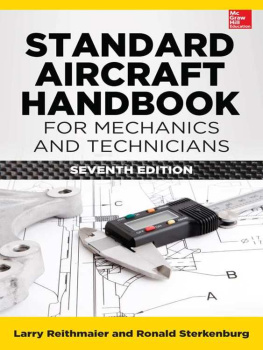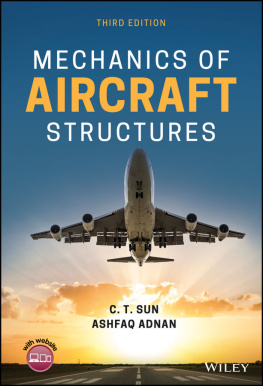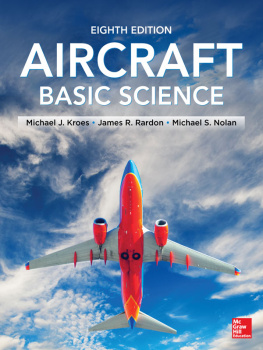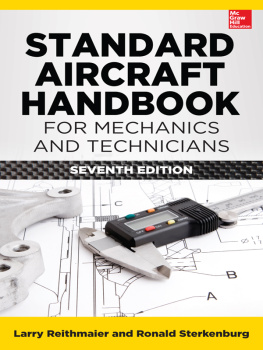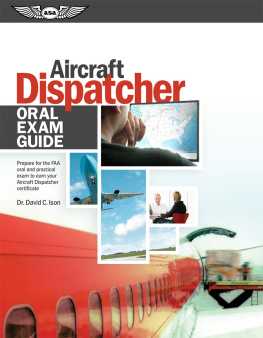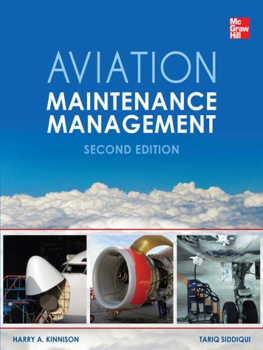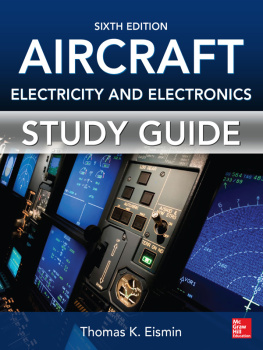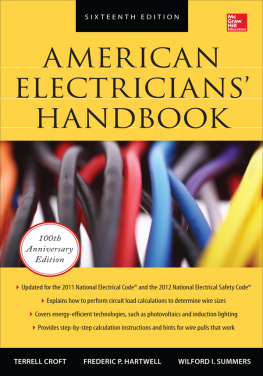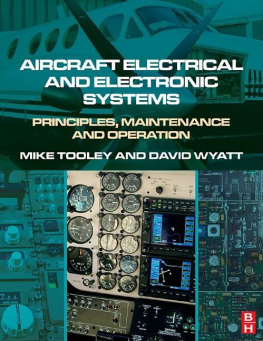Standard Aircraft Handbook for Mechanics and Technicians
ABOUT THE EDITORS
Larry Reithmaier , a retired aerospace engineer, helped design and develop jet fighter and bomber aircraft and NASA spacecraft. He has a degree in mechanical engineering and holds the following FAA certificates: Commericial/Instrument Pilot, Flight/Ground Instructor, and Airframe and Powerplant (A&P) Mechanic. The author of several technical books on aviation, Mr. Reithmaier has also written the Aviation and Space Dictionary, Mach I and Beyond, the Private Pilots Guide, and the Instrument Pilots Guide .
Ronald Sterkenburg started teaching at Purdue University in 1999 after a 20-year career in the U.S. Navy. He is the author or co-author of 10 books and more than 60 articles in national and international journals and conference proceedings. The focus of Dr. Sterkenburgs research is the repair of metallic and composite aircraft structures. He is a certificated Airframe and Powerplant (A&P) Mechanic, holds an Inspection Authorization (IA), and is a Designated Mechanic Examiner (DME).
Standard Aircraft Handbook for Mechanics and Technicians
Edited by Larry Reithmaier and Ronald Sterkenburg
Seventh Edition
New York Chicago San Francisco Athens London
Madrid Mexico City Milan New Delhi
Singapore Sydney Toronto
Copyright 2014 by McGraw-Hill Education. All rights reserved. Except as permitted under the United States Copyright Act of 1976, no part of this publication may be reproduced or distributed in any form or by any means, or stored in a database or retrieval system, without the prior written permission of the publisher.
ISBN: 978-0-07-182680-8
MHID: 0-07-182680-7
e-Book conversion by Cenveo Publisher Services
Version 1.0
The material in this eBook also appears in the print version of this title: ISBN: 978-0-07-182679-2, MHID: 0-07-182679-3.
McGraw-Hill Education eBooks are available at special quantity discounts to use as premiums and sales promotions, or for use in corporate training programs. To contact a representative, please visit the Contact Us page at www.mhprofessional.com.
All trademarks are trademarks of their respective owners. Rather than put a trademark symbol after every occurrence of a trademarked name, we use names in an editorial fashion only, and to the benefit of the trademark owner, with no intention of infringement of the trademark. Where such designations appear in this book, they have been printed with initial caps.
Information has been obtained by McGraw-Hill Education from sources believed to be reliable. However, because of the possibility of human or mechanical error by our sources, McGraw-Hill Education, or others, McGraw-Hill Education does not guarantee the accuracy, adequacy, or completeness of any information and is not responsible for any errors or omissions or the results obtained from the use of such information.
TERMS OF USE
This is a copyrighted work and McGraw-Hill Education and its licensors reserve all rights in and to the work. Use of this work is subject to these terms. Except as permitted under the Copyright Act of 1976 and the right to store and retrieve one copy of the work, you may not decompile, disassemble, reverse engineer, reproduce, modify, create derivative works based upon, transmit, distribute, disseminate, sell, publish or sublicense the work or any part of it without McGraw-Hill Educations prior consent. You may use the work for your own noncommercial and personal use; any other use of the work is strictly prohibited. Your right to use the work may be terminated if you fail to comply with these terms.
THE WORK IS PROVIDED AS IS. McGRAW-HILL EDUCATION AND ITS LICENSORS MAKE NO GUARANTEES OR WARRANTIES AS TO THE ACCURACY, ADEQUACY OR COMPLETENESS OF OR RESULTS TO BE OBTAINED FROM USING THE WORK, INCLUDING ANY INFORMATION THAT CAN BE ACCESSED THROUGH THE WORK VIA HYPERLINK OR OTHERWISE, AND EXPRESSLY DISCLAIM ANY WARRANTY, EXPRESS OR IMPLIED, INCLUDING BUT NOT LIMITED TO IMPLIED WARRANTIES OF MERCHANTABILITY OR FITNESS FOR A PARTICULAR PURPOSE. McGraw-Hill Education and its licensors do not warrant or guarantee that the functions contained in the work will meet your requirements or that its operation will be uninterrupted or error free. Neither McGraw-Hill Education nor its licensors shall be liable to you or anyone else for any inaccuracy, error or omission, regardless of cause, in the work or for any damages resulting therefrom. McGraw-Hill Education has no responsibility for the content of any information accessed through the work. Under no circumstances shall McGraw-Hill Education and/or its licensors be liable for any indirect, incidental, special, punitive, consequential or similar damages that result from the use of or inability to use the work, even if any of them has been advised of the possibility of such damages. This limitation of liability shall apply to any claim or cause whatsoever whether such claim or cause arises in contract, tort or otherwise.

Contents
Preface
The Standard Aircraft Handbook for Mechanics and Technicians is presented in shop terms for the mechanics and technicians engaged in building, maintaining, overhauling, and repairing metal and composite aircraft. It is also useful for the student mechanic, who must acquire the basic mechanical skills fundamental to every technical specialty.
This handbook is a relatively complete guide to all basic shop practices, such as use of basic tools, drilling, riveting, sheet-metal forming, use of threaded fasteners, and installation of plumbing, cables, and electrical wiring. Chapters on nondestructive testing (NDT) and corrosion detection and control provide a guide to advanced technology inspection and detection equipment, techniques, and procedures.
For the Seventh Edition, the editors updated all existing chapters with new relevant information and figures to reflect current technologies, hardware, and materials used for aircraft maintenance. A new chapter was added to the handbook to provide information about composite materials such as carbon fiber used in modern aircraft models.
The information presented in this handbook was obtained from techniques and procedures developed by various aircraft and equipment manufacturers and is in general compliance with manufacturing specifications.
This handbook is not intended to replace, substitute for, or supersede any FAA regulations, shop and quality-control standards of an aircraft manufacturer, repair station, or manufacturers maintenance manual.
Acknowledgments
Extensive use was made of data, information, illustrations, and photographs supplied by:
Lockheed Corporation
Rockwell International, NAAO
Federal Aviation Administration
Hi-Shear Corporation

